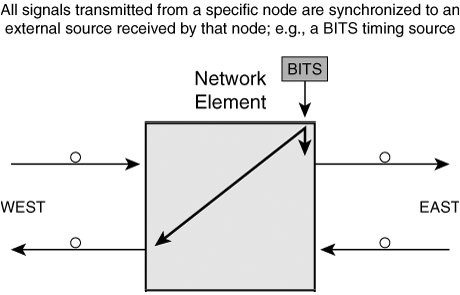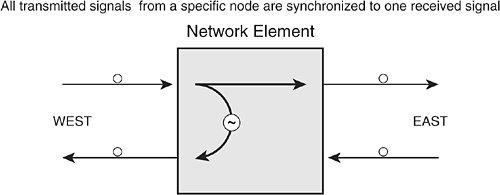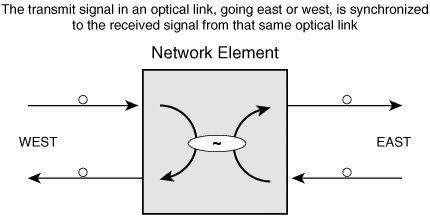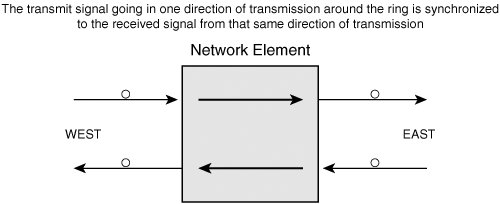Synchronization and Timing
| Synchronization is an important part of any digital time-division network. If network elements are not synchronized, entire frames of the SONET/SDH signal will occasionally be lost. Losing a frame means that all the data bits or voice samples carried within the frame are lost. Clearly, slips must be minimized to provide high-quality transmission. Digital time-division networks operate at a fundamental frequency of 8 KHz. This frequency was derived from the desire to support voice communication with a 4-KHz bandwidth. All network elements that perform switching or multiplexing have an internal clock that operates at 8 KHz. As a general rule, clocks don't keep perfect time. They have a nominal operating frequency, but they drift over time. The better the quality of the oscillator in the watch, the less the clock drifts. The same is true of the clock in network elements. Two adjacent switches operating with independent clocks (called free running) will drift relative to one another. If they drift too much, a "slip" occurs. A slip results in dropping or duplicating a time-division frame that contains voice or data. To avoid slips, network clocks must be synchronized, such as with two time-division network elementsfor example, these could be switches, multiplexers, or cross-connects. All network elements operate at a nominal frequency of 8000 samples per second, or 1 sample every 125 microseconds. If two network elements are operating independently with their own internal clocks, inevitably the two clock rates will drift relative to one another, and one clock will be slightly faster than the other. This faster operation means that data is being sent at a higher rate than the other clock is processing it (because it has a slower clock). The receiving node buffers the excess bits that arrive until it has an entire time-division frame (that is, a DS1 frame or an STS-1 frame) of information that it hasn't yet processed. At that point, to realign the clocks and avoid falling even further behind, the receiving node discards the extra frame. This frame discard is called a slip. In the opposite direction, the "faster" switch is receiving the incoming signal at a slower rate than its clock rate. Eventually, the switch gets to the point at which its incoming frame buffer is empty. At that point, to realign the two nodes, the switch repeats the previous frame of information. No data is lost, but the same data is sent twice. This overwriting of information is also called a slip. Slips lead to loss or duplication of a time-division frame. This is an obvious problem for digital data. Occasional slips are tolerated, but each slip can lead to one or more retransmissions of data. Excessive slips not only affect the performance of the application, but they also can lead to network-congestion problems if the volume of retransmissions is too great. Voice is surprisingly tolerant of slips. Unofficial subjective tests have been completed to show that users will tolerate slip rates of as high as one slip per 100 samples before they complain about call quality. This is an extremely high slip rate. When slips do become noticeable, they tend to produce audible pops and clicks that can become annoying. Timing slips need to be eliminated. Since digital switching was introduced to the public switched digital network in 1976, a synchronization plan has been in place to ensure that network elements can trace their timing reference to a common clock. The plan has evolved over the years, but it's still the primary defense against slips. To address this situation, SONET and SDH have defined a clever pointer-adjustment scheme using the H3 byte of the line overhead. The pointer adjustments allow the network to tolerate small frequency differences without incurring slips. TimingEvery SONET/SDH network element has its own internal clock. When the element operates using its own clock, it is said to be free running. The highest-quality clock used in communications networks is called a Stratum 1 clock. It is also referred to as the primary reference source. Two free-running switches with Stratum 1 clocks would experience about five slips per year. The simple solution to the slip problem is to design every network node with a Stratum 1 clock. The problem with this idea has been cost. Stratum 1 clocks are expensive, so the Bell System of the 1970s had one Stratum 1 clock located in the geographic center of the country (Missouri). The alternative plan was to design each network element with its own lower-quality internal clock and tie the clock back to a Stratum 1 clock. As long as the internal clock is tied to the Stratum 1, it will operate at the Stratum 1 frequency. If it loses its link to Stratum 1, it will eventually free-run. Four quality or accuracy levels for timing sources have been defined for digital networks. As you go down the chain from Stratum 1 to Stratum 4, the clock quality and cost go down. Any clock will operate at the Stratum 1 frequency, as long as it has a timing chain or connection to a Stratum 1 clock. The difference in clock quality shows up when the timing chain is broken and the clocks go into free-running mode. Typically there are two measures of clock quality: accuracy and holdover capability. Accuracy is the free-running accuracy of the clock. Holdover is essentially a measure of how well the clock "remembers" the Stratum 1 clock frequency after the timing chain is broken. It is usually measured in terms of clock accuracy during the first 24 hours after a timing failure. The idea is that if timing can be restored within the first 24 hours, the network is operating at the holdover accuracy instead of the free-running accuracy. Table 2-2 describes the different quality levels or stratum values of clocks.
So where do you find a Stratum 1 clock that is affordable enough to deploy over a large network? Try using a Global Positioning System receiver. Global Positioning SystemThanks to the current availability of the Global Positioning System (GPS), networks can take advantage of a cheap source for Stratum 1 timing. Inexpensive GPS receivers make it possible to have a Stratum 1 clock source in nearly every location. Timing distribution is accomplished through the use of Building Integrated Timing Source (BITS) and the BITS synchronization method. Figure 2-26 displays how this method is deployed. BITS normally provides two Stratum 1 clocks. One is used for normal operation; the other is used for backup. Inside the central office (CO), an empty DS1 or E1 channel is used to carry the clocking information for the network elements (NEs) located in the CO. Therefore, each rack inside the CO is connected to the BITS source. Typical service-provider equipment has a connection point for BITS input. It can use any physical interface defined for E1, such as coax or wire-wrap pins to connect to BITS. Several rules are related to the BITS synchronization method. A typical carrier NE is normally equipped with a Stratum 3 clock. This clock is used when the NE is free running, without synchronization, toward an external clock source. In case of network synchronization, this NE runs at the same rate as the Stratum 1 reference clock. The maximum slip rate allowed for a free-running SONET NE is 20 ppm. This is between the accuracy of a Stratum 3 and Stratum 4 clock. A Stratum 3 clock source is more expensive than a Stratum 4 clock source. Packet-switching devices use buffering, so they do not need precise clock synchronization. Therefore, a Stratum 4 clock is reasonable for this use. Cisco routers are typically equipped with a Stratum 4 clock. Service-provider NEs have a higher price tag and higher need for precise transmit clocks. Thus, a Stratum 3 clock is the correct choice because Stratum 4 is not good enough for DS-3. In Figure 2-26, you can see a CO location and three other locations. If you had a BITS in all four locations, you would option all four nodes to be externally timed from each respective BITS source. This would ensure that your network would have the best synchronization plan available. So what do you do when the three locations don't have a BITS available for direct connection? You must use an alternative method to synchronize an MSPP network element. Figure 2-26. BITS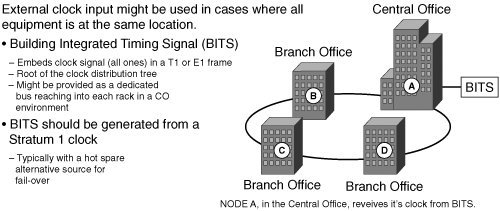 Some alternative ways to synchronize an MSPP network element where there is no external timing source include line timing, loop timing, and through timing. The first method of performing timing is to use an external clock source, such as the BITS. The BITS supplies your NE with an external clock source that the NE uses to time the outgoing transmission lines. Normally, the BITS is equipped with a primary clock generator and a secondary clock generator for backup. Figure 2-27 shows an example of external timing. Figure 2-27. External Timing If no external timing source is available, you can use one of the incoming lines to regenerate the clocking signal. The incoming signal that has the shortest path to a primary reference source should be selected. In line timing, the clock is recovered from the received signal and is used to time all outgoing transmission lines. If there is more than one incoming line, such as at a cross-connect, and the sources of the different line signals are not synchronized, slips can occur. Figure 2-28 shows an example of line timing. Figure 2-28. Line Timing Two other methods of synchronization are loop timing and through timing. Figures 2-29 and 2-30 shed some light on loop timing and through timing. Figure 2-29. Loop Timing Figure 2-30. Through Timing In loop timing, you use the incoming line signal as the timing source for the signal that is transmitted on the same interface. Loop timing is normally not used in ADMs or cross-connects that have multiple external interfaces because if data is sent from the incoming West channel to the outgoing East channel and both clocks are not accurate, slips can occur. Through timing is normally used in ring configurations. The transmit signal in one direction of transmission is synchronized with the received signal from the same direction of transmission. Through timing is also typically used by SONET signal regenerators, which normally only pass the data through the machinery, without cross-connect functionality. |
EAN: 2147483647
Pages: 140
- Structures, Processes and Relational Mechanisms for IT Governance
- An Emerging Strategy for E-Business IT Governance
- Linking the IT Balanced Scorecard to the Business Objectives at a Major Canadian Financial Group
- A View on Knowledge Management: Utilizing a Balanced Scorecard Methodology for Analyzing Knowledge Metrics
- Governance in IT Outsourcing Partnerships
